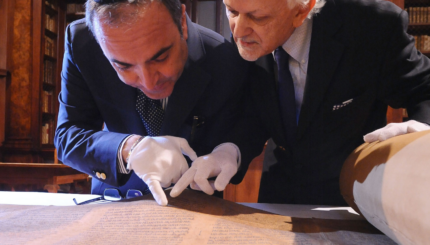While we speak often of “the Midrash,” there is no single book with this title, but only a series of compilations composed and edited over the course of more than a millennium. These works are generally categorized as either halachic (legal) or aggadic (narrative), though this dichotomy obscures the extent to which so-called halachic midrashim also include narrative material and to which aggadic midrashim also contain legal material.
One of the works that best exemplifies this intermingling of legal and narrative material is Midrash Tanhuma, a collection of stories, discussions of specific laws, and rabbinic homilies, all connected with the five books of the Torah and named for Rabbi Tanhuma, the first character to appear in the collection. The compilation moves effortlessly between genres, reminding us of the interdependency within the Jewish tradition of halacha and aggadah.
Two types of midrashim, though not exclusive to Midrash Tanhuma, appear more frequently here than in other collections. These two genres are the petihta, a homiletic introduction to a section of the text; and midrash yelamdenu, a legal discourse based on the biblical text. The latter is so prevalent within Tanhuma that an alternate name for the book is Midrash Yelamdenu. Though some scholars believe that Tanhuma, comprising the narrative portions of the midrash, and Midrash Yelamdenu, consisting only of legal discussions, may once have been two separate books, the two names have been interchangeable since at least the middle ages.
The Petihta
The petihta, or opening (generally translated into English as “proem”), marks the beginning of a section of the Torah as divided for public synagogue reading. The divisions preserved by these petihtaot (plural of petihta) reflect the triennial cycle of synagogue readings prevalent in ancient Palestine, in which the Torah would be read in sequence over the course of three years. (In contrast, the triennial divisions used by many contemporary synagogues divide each parashah into thirds.)
With your help, My Jewish Learning can provide endless opportunities for learning, connection and discovery.
The petihta begins with a verse from elsewhere in the Bible, most often from the books of Proverbs or Psalms. This verse prompts a discourse that eventually finds its way back to the first verse of the weekly Torah reading. For instance, a petihta introducing the first verse of the book of Exodus begins by quoting Psalms 48:11, “The praise of you, God, like your name, reaches to the ends of the earth.”
The petihta continues with a discussion of names, identifying four types of people: those who, like God, have beautiful names and beautiful deeds; those with beautiful names and ugly deeds; those with ugly names and beautiful deeds; and those with ugly names and ugly deeds. After laying out these four categories, the text asserts that Jacob’s children were beautiful both in name and deed, and then returns us to the first verse of Exodus, “These are the names of the children of Israel who went down to Egypt.” A particular verse may have more than one petihta attached to it.
Midrash Yelamdenu
The yelamdenu midrashim are immediately identifiable by their first words, “Yelamdenu Rabbenu” or, “Teach us, Rabbi.” What follows is a legal question, generally one whose answer is well known from the Mishnah or another legal source. For example, a yelamdenu midrash introducing the verse “God spoke to Moses saying, I am Adonai” (Exodus 6:2) asks, “Teach us, Rabbi, what is the punishment for one who pronounces God’s ineffable name.” The midrash goes on to derive the answer through exegesis of the verse in question.
The punishment for one who pronounces God’s name is mentioned by the Mishnah, which predates Tanhuma by several centuries, and is discussed in-depth by the Gemara, which probably also predates the midrash. There would be no reason, then, for the author of the midrash mentioned above to be genuinely in doubt about the appropriate punishment for pronouncing God’s name.
Rather, the midrashic discussion of this legal issue appears to act primarily as a mnemonic device, rather than as an attempt to solve a previously unanswered question. A person might be able to find the law in question explained more succinctly elsewhere, but might be more likely to remember this law once it is attached to a familiar verse. As yelamdenu midrashim often appear at the beginning of a Torah reading section, they may be understood as parallel to the petihtaot.
Dating of the Midrash
Discussions of the dating of Tanhuma are complicated by the existence of two separate editions of the text: the standard printed edition, based on a 16th century manuscript from Constantinople; and an edition based on several manuscripts from the Oxford library, published by Solomon Buber in the late 19th century. Some sections of these two versions are virtually identical, while other sections differ greatly. The relationship between these two texts remains a matter of scholarly debate. One text may represent an earlier edition or, alternately, the two may have developed separately out of the same tradition.
Cultural references within the text, combined with linguistic similarities between Midrash Tanhuma and certain early medieval writings suggest that this midrash may have been edited around the ninth century, though elements of the text are probably centuries older. Midrash Tanhuma reflects the influence of other, older collections of midrash. In many cases, the same text in various forms appears both in Tanhuma and in other compilations.
Use of the Midrash by Medieval Exegetes
Perhaps no one has done more for the diffusion of Midrash Tanhuma than Rashi, the 11th century commentator who remains the best-known Jewish exegete. Rashi’s commentary displays a decidedly midrashic bent, and Tanhuma appears to have been the primary source for many of his interpretations. Later commentators both incorporate Tanhuma into their own commentaries and challenge Rashi’s reliance on this midrashic material to support difficult passages. For instance, the 14th century commentator Ramban (Nahmanides) often rejects Rashi’s midrashic explanations saying, in one place, “He derives knowledge from aggadah (stories).” At the same time, Ramban periodically relies on Tanhuma for his own interpretation.
While perhaps not a household name, Midrash Tanhuma has had a major effect on our understanding of the biblical text and of the relationship between biblical text and Jewish law.
Midrash
Pronounced: MIDD-rash, Origin: Hebrew, the process of interpretation by which the rabbis filled in “gaps” found in the Torah.
Mishnah
Pronounced: MISH-nuh, Origin: Hebrew, code of Jewish law compiled in the first centuries of the Common Era. Together with the Gemara, it makes up the Talmud.
Torah
Pronunced: TORE-uh, Origin: Hebrew, the Five Books of Moses.



